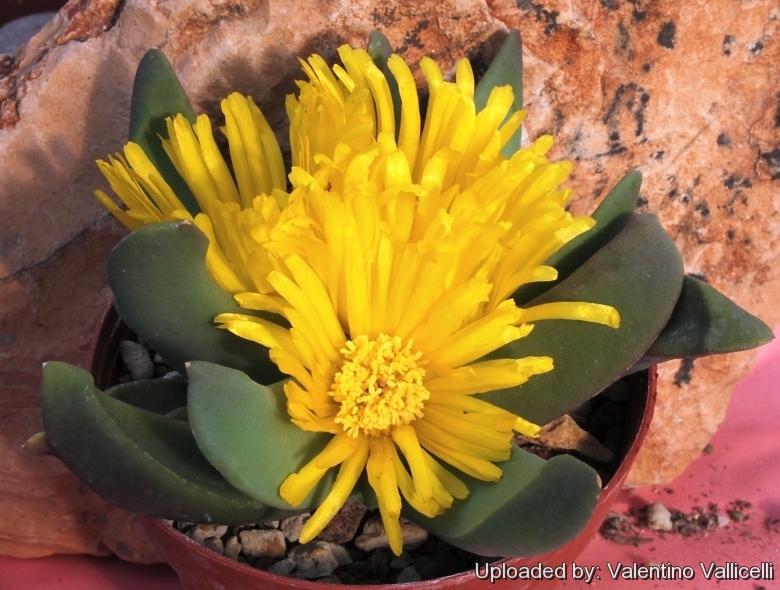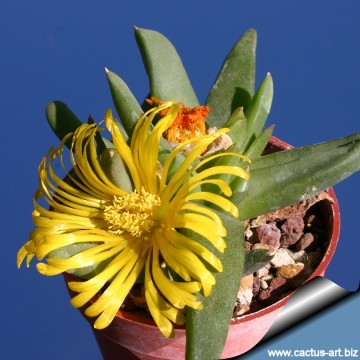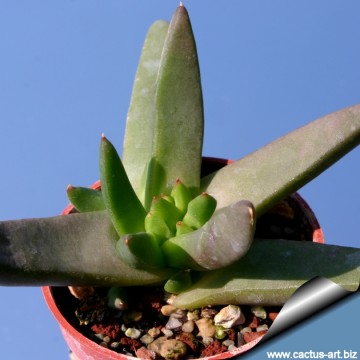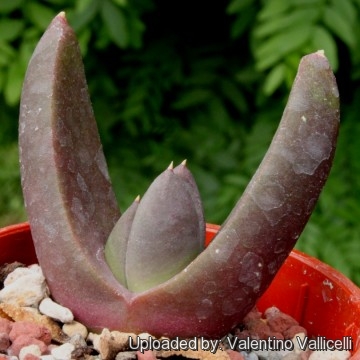
Glottiphyllum suave Photo by: Valentino Vallicelli
The flowers are a very cheerful yellow daisy flower, and the following seed pods are really cool. They are often grown because of their irresistibility to be touched. People cannot walk past them without giving the leaves a gentle squeeze.
Origin and Habitat: Native of the drier areas of the Cape (South africa)
Habitat: Grows in a region that consists of flat plains or gently rolling hills - that seem to just go on for miles in every direction - completely covered with small sandstone fragments of quartz atop rocky soil. Some plant in habitat have scars or burst in their skins, just like they do at home.
Synonyms:
See all synonyms of Glottiphyllum suave
back
Accepted name in llifle Database:Glottiphyllum suave N.E.Br.Gard. Chron. 1928, Ser. III. lxxxiii. 13.Synonymy: 3
back
Common Names include:
ENGLISH: Tounge-Leaf
Description: Small, compact, very succulent, prostrate, clump-forming plant that forms whorls of waxy green leaves up to 10 cm in diameter (but often more in cultivation). There are indeed marked differences in sizes of leaf and flowers in plants from different population and also the growing condition (especially sun exposure) determine differences in habit of cultivate specimens.
Stem: Almost stem less.
Leaves: In 2 to 4 ranks, equal or moderately unequally tongue-shaped, tapered to to a sharp point, soft, glossy, light absorbing, and dark-green to waxy grey. They are succulent and very juicy in texture, reminiscent of gummy bears, in full sun they assume a purplish colouring
Flowers: Bright yellow, large (4-8 cm in diameter), daisy-like, scented and very showy. They are clustered near the centre of the rosette. They are self-sterile, which means that you need different plants from the same location to obtain seeds.
Blooming season:The conspicuous flowers come mostly in late Autumn through to late in winter. Glottiphyllum suaveSN|1091]]SN|1091]] (differently to other mesembs that expand their flowers only in bright sunshine) will expand its flowers in a very dim light too. These very large golden yellow flowers open in all weathers and have a perfume resembling mimosa.
Subspecies, varieties, forms and cultivars of plants belonging to the Glottiphyllum suave group
Notes: The 50 or so species of glottiphyllums are so similar that many may be hybrids.
Bibliography: Major references and further lectures
1) Ernst Van Jaarsveld, Ben-Erik Van Wyk, Gideon Smith Succulents of South Africa: A Guide to the Regional Diversity Tafelberg Publishers, Limited, 01/lug/2000
2) Gustav Schwantes The Cultivation of the Mesembrythemaceae Blandford Press, 1954
3) Heidrun E. K. Hartmann Illustrated Handbook of Succulent Plants: Aizoaceae F-Z Springer, 2002
4) James Cullen, Sabina G. Knees, H. Suzanne Cubey The European Garden Flora Flowering Plants: A Manual for the Identification of Plants Cultivated in Europe, Both Out-of-Doors and Under Glass Cambridge University Press, 11/ago/2011
5) Gardeners' Chronicle, Horticultural Trade Journal, Volume 83 Haymarket Publishing, 1928
 Glottiphyllum suave Photo by: Cactus Art
Glottiphyllum suave Photo by: Cactus Art Glottiphyllum suave Photo by: Cactus Art
Glottiphyllum suave Photo by: Cactus Art Glottiphyllum suave Photo by: Cactus Art
Glottiphyllum suave Photo by: Cactus Art Glottiphyllum suave Photo by: Valentino Vallicelli
Glottiphyllum suave Photo by: Valentino Vallicelli Glottiphyllum suave Photo by: Valentino Vallicelli
Glottiphyllum suave Photo by: Valentino Vallicelli Glottiphyllum suave Photo by: Cactus Art
Glottiphyllum suave Photo by: Cactus ArtCultivation and Propagation: The plants in this genus represent some of the more easily cultivated succulent species. Their main growth period is in late winter and were heading for spring-summer dormancy, but they do best with at least a little water all year.
Soil: It grows best in sandy-gritty soil and requires good drainage as it it is prone to root rot. It can grows outdoor in sunny, dry, rock crevices (protection against winter wet is required) It can also be cultivated in alpine house, in poor, drained soil.
Fertilization: Feed it once during the growing season with a fertilizer specifically formulated for cactus and succulents (poor in nitrogen), including all micro nutrients and trace elements diluted to ½ the strength recommended on the label.
Watering: Requires little water otherwise their epidermis breaks (resulting in unsightly scars). Water moderately from the middle of summer to the end of winter, and keep the compost almost dry when the plants are dormant (only occasional misting). Water minimally in spring and summer, only when the plant starts shrivelling (, but they will generally grow even in summer if given water). If grown in a container, bottom watering by immersing the container is recommended. It must have very dry atmosphere.
Exposition: Keep cool and shaded in summer, but provide maximum light the rest of the year. Remember that a sunny locality is best, otherwise they will not flower properly.
Hardiness: It prefer a very bright situation and require a minimum temperature 5°C (But will take a light frost and is hardy down to -7° C for short periods if it is in dry soil). USDA zones 9A – 11. In areas prone to frost, grow in an intermediate greenhouse or conservatory, in pots.
Pests and diseases: Soft leaves mean easy to damage. May be susceptible to mealybugs and rarely scale.
Uses: Container, rock garden.
Remarks: However there are two ways to grow glottiphyllums: The first is to let nature take her course, which means giving them large pots and copious water; they will burgeon into enormous masses of glistening green leaves. The other is to starve them into svelteness by hot summer droughts, small pots, and firm loam. The results can be very attractive. In any case it is best to treat them as late winter growers.
Notes: The 50 or so species of this South African genus of succulents are so similar that many may be hybrids.
Propagation: Seeds or cuttings. Seeds germinate very easily and can be sown in early to mid-spring, but can be sown at most times of the year (Avoid very hot weather in summer) and germinated in heated humid environment. Do not sow the seeds too deep. If sown too deep, they will be smothered and probably not germinate. Under ideal conditions, seedlings will grow rapidly. Plant the seedlings out when they are 3–5 cm in height.
Alternatively, use stem cuttings taken towards the end of summer in an heated propagating case (15-21°C) Cuttings root easily and remain true to the species, while seeds tend to hybridize.

















